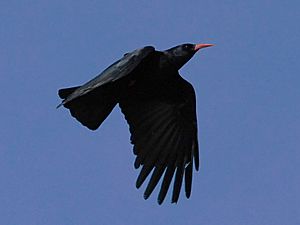Birds of Cornwall facts for kids
The birds of Cornwall are a mix of birds found across the British Isles. Because Cornwall is at the very southwest tip of Great Britain, many birds passing through stop there. For example, the nightingale, a common English bird, is rarely seen in Cornwall.
Along the coasts, the tidal estuaries (where rivers meet the sea) are home to many wading birds that walk in shallow water. Inland, marshland (wet, grassy areas) and bogs (wet, spongy ground) attract other bird species. Bodmin Moor is a special place where birds like lapwings, snipes, and curlews raise their young. Near rivers, you can often spot sand martins and kingfishers.
The tall sea cliffs are perfect for many marine birds. The red-billed chough has recently returned to Cornwall after being away for a long time. This special bird is even on the Cornish coat of arms and is the official animal of Cornwall! The chough found here is a specific type, Pyrrhocorax pyrrhocorax pyrrhocorax, which is unique to the British Isles.
Contents
Birds of North Cornwall

The coast around Tintagel is a great place to watch birds. In 1935, people saw huge groups of seabirds there. Inland, ravens and falcons were common. The red-billed chough, which is a symbol of Cornwall and is even linked to the legend of King Arthur, was once found here but disappeared by the 1950s. Luckily, they have now returned!
The razorbill used to have one of the largest colonies in Cornwall near Tintagel. A local bird keeper, Jon Hadwick, wrote a book called Owl Light in 1991 about his experiences with ten owls and a buzzard. Charles Hambly, an early member of the Royal Society for the Protection of Birds, helped protect birds in the area. Even with modern farming, bird populations have remained strong.
Near Polzeath, the coastline is excellent for seeing many types of coastal birds, including puffins and peregrine falcons.
Camel Valley Birds
The River Camel estuary has large areas of salt marsh, making it a perfect spot for birds. In winter, you can see huge groups of waders, which are sometimes hunted by local peregrines. A migrating osprey often stops for a few days in spring and autumn to fish.
Mute swans build nests in several places along the river, especially near the bridge in Wadebridge. You can also find different types of ducks, like shelduck, shoveller, and mallard in the estuary, and teal further upstream.
The Camel estuary was one of the first places in England where little egrets started to live. These birds are often seen on the mudflats when the tide is low. Very rare birds have also been spotted here, like an American belted kingfisher in the 1980s, which was only the second time one had been seen in England.
Upstream on the River Camel, and on its smaller rivers, you can see kingfishers. The Cornwall Wildlife Trust's reserve at Hawkes Wood is known for its nuthatches and tawny owls.
There are two special places called birdwatching hides on the River Camel. Tregunna Hide (at grid reference SW 969 738) is open to everyone and is on the Camel Trail. Burniere Hide (at grid reference SW 982 740) is owned by the Cornwall Birdwatching and Preservation Society (CBWPS) and is only for their members. The CBWPS also owns the Walmsley Sanctuary, which is over 20 hectares (49 acres) on the River Amble (a river that flows into the Camel). This sanctuary has two more hides for members and is very important for waders and wildfowl that spend the winter there.
Birds of West Cornwall
Gwennap Head is famous for the many marine birds that pass by, such as Manx and sooty shearwaters, skuas, petrels, and whimbrels. There is also a group of gannets that nest nearby. Because of this, birdwatchers love this headland, and many travel from all over Britain to see rare seabirds. Every year, the Seawatch SW group counts these birds from a spot on the cliff edge at Gwennap Head.
West Penwith, which is almost cut off from the rest of Cornwall, has fewer types of birds living there all the time, and their numbers are smaller. However, the only groups of kittiwakes in Cornwall are found in west Penwith. Also, the only times yellow wagtails have been recorded nesting in the county were in this area.
Birds of the Isles of Scilly
The Isles of Scilly have a very mild climate because of the Gulf Stream, which means plants from warmer places can grow there. Scilly is often the first place many migrating birds land, including very rare ones from North America and Siberia. Since Scilly is far out in the Atlantic Ocean, many birds that get lost from North America will first arrive there in Europe.
Scilly has been the first place in Britain to see many rare birds. If a super rare bird shows up, the islands get a big increase in visiting birdwatchers!
Bird Experts in Scilly
Will Wagstaff is a well-known ornithologist (a scientist who studies birds) and naturalist (someone who studies nature) in the Isles of Scilly. He is also an author. His popular guided wildlife walks have made him a famous person on the islands. Will Wagstaff moved to the Isles of Scilly in 1981 and, as of 2012, he is the Honorary President and Chairman of the Isles of Scilly Bird Group.
Periglis Cottage on St Agnes, Isles of Scilly was the home of Hilda M. Quick, a bird expert who lived on St Agnes. She wrote a book called Birds of the Scilly Isles, which was published in 1964.
David Bassil Hunt was another important bird expert. He was known as "the man who brought Scilly wildlife into the lives of thousands of people over a period of 20 years." He lived on the Isles of Scilly for many years and worked as a guide for birding tours around the world. His life story, Confessions of a Scilly Birdman, was published the year he passed away.
Bird Sanctuaries
- The Cornish Birds of Prey Centre is a special place near St Columb Major that helps birds of prey.
- Mousehole Wild Bird Hospital and Sanctuary is a hospital for wildlife located near Mousehole. It was started in 1928 by Dorothy and Phyllis Yglesias. It became very well known after the Torrey Canyon oil spill disaster, when it helped many oiled birds.
- The Screech Owl Sanctuary is a safe place for sick and injured owls near St Columb Major. The sanctuary cares for hundreds of owls of different types. Their work was recognized with an award from the BBC in 2002.
- The Cornwall Birdwatching and Preservation Society owns the Walmsley Sanctuary. This sanctuary covers over 20 hectares (49 acres) on the River Amble, which flows into the River Camel. It has two hides for its members to use. This sanctuary is very important for waders and wildfowl that spend the winter there. The land for the sanctuary was bought in 1939 using money left by Dr. Robert Garrett Walmsley. He wanted the society to create a "Sanctuary for Migrating Waders within the Duchy of Cornwall." The land, known as Lower Amble Marshes, is 42 acres and is in the parish of St Kew.
Images for kids





